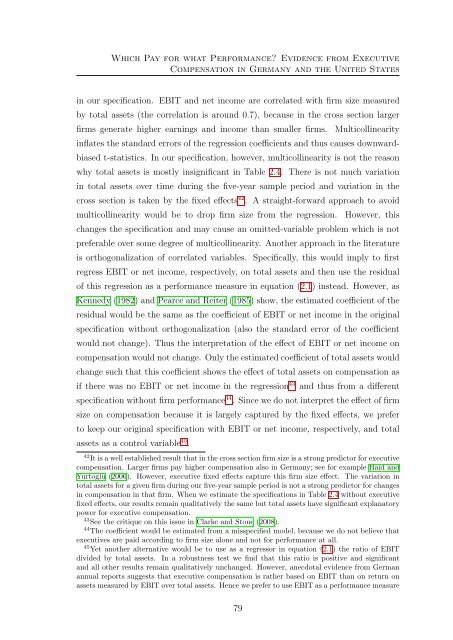Three Essays on Executive Compensation - KOPS - Universität ...
Three Essays on Executive Compensation - KOPS - Universität ...
Three Essays on Executive Compensation - KOPS - Universität ...
Create successful ePaper yourself
Turn your PDF publications into a flip-book with our unique Google optimized e-Paper software.
Which Pay for what Performance? Evidence from <strong>Executive</strong><br />
Compensati<strong>on</strong> in Germany and the United States<br />
in our specificati<strong>on</strong>. EBIT and net income are correlated with firm size measured<br />
by total assets (the correlati<strong>on</strong> is around 0.7), because in the cross secti<strong>on</strong> larger<br />
firms generate higher earnings and income than smaller firms.<br />
Multicollinearity<br />
inflates the standard errors of the regressi<strong>on</strong> coefficients and thus causes downwardbiased<br />
t-statistics. In our specificati<strong>on</strong>, however, multicollinearity is not the reas<strong>on</strong><br />
why total assets is mostly insignificant in Table 2.4. There is not much variati<strong>on</strong><br />
in total assets over time during the five-year sample period and variati<strong>on</strong> in the<br />
cross secti<strong>on</strong> is taken by the fixed effects 42 . A straight-forward approach to avoid<br />
multicollinearity would be to drop firm size from the regressi<strong>on</strong>.<br />
However, this<br />
changes the specificati<strong>on</strong> and may cause an omitted-variable problem which is not<br />
preferable over some degree of multicollinearity. Another approach in the literature<br />
is orthog<strong>on</strong>alizati<strong>on</strong> of correlated variables. Specifically, this would imply to first<br />
regress EBIT or net income, respectively, <strong>on</strong> total assets and then use the residual<br />
of this regressi<strong>on</strong> as a performance measure in equati<strong>on</strong> (2.1) instead. However, as<br />
Kennedy (1982) and Pearce and Reiter (1985) show, the estimated coefficient of the<br />
residual would be the same as the coefficient of EBIT or net income in the original<br />
specificati<strong>on</strong> without orthog<strong>on</strong>alizati<strong>on</strong> (also the standard error of the coefficient<br />
would not change). Thus the interpretati<strong>on</strong> of the effect of EBIT or net income <strong>on</strong><br />
compensati<strong>on</strong> would not change. Only the estimated coefficient of total assets would<br />
change such that this coefficient shows the effect of total assets <strong>on</strong> compensati<strong>on</strong> as<br />
if there was no EBIT or net income in the regressi<strong>on</strong> 43 and thus from a different<br />
specificati<strong>on</strong> without firm performance 44 . Since we do not interpret the effect of firm<br />
size <strong>on</strong> compensati<strong>on</strong> because it is largely captured by the fixed effects, we prefer<br />
to keep our original specificati<strong>on</strong> with EBIT or net income, respectively, and total<br />
assets as a c<strong>on</strong>trol variable 45 .<br />
42 It is a well established result that in the cross secti<strong>on</strong> firm size is a str<strong>on</strong>g predictor for executive<br />
compensati<strong>on</strong>. Larger firms pay higher compensati<strong>on</strong> also in Germany; see for example Haid and<br />
Yurtoglu (2006). However, executive fixed effects capture this firm size effect. The variati<strong>on</strong> in<br />
total assets for a given firm during our five-year sample period is not a str<strong>on</strong>g predictor for changes<br />
in compensati<strong>on</strong> in that firm. When we estimate the specificati<strong>on</strong>s in Table 2.4 without executive<br />
fixed effects, our results remain qualitatively the same but total assets have significant explanatory<br />
power for executive compensati<strong>on</strong>.<br />
43 See the critique <strong>on</strong> this issue in Clarke and St<strong>on</strong>e (2008).<br />
44 The coefficient would be estimated from a misspecified model, because we do not believe that<br />
executives are paid according to firm size al<strong>on</strong>e and not for performance at all.<br />
45 Yet another alternative would be to use as a regressor in equati<strong>on</strong> (2.1) the ratio of EBIT<br />
divided by total assets. In a robustness test we find that this ratio is positive and significant<br />
and all other results remain qualitatively unchanged. However, anecdotal evidence from German<br />
annual reports suggests that executive compensati<strong>on</strong> is rather based <strong>on</strong> EBIT than <strong>on</strong> return <strong>on</strong><br />
assets measured by EBIT over total assets. Hence we prefer to use EBIT as a performance measure<br />
79
















